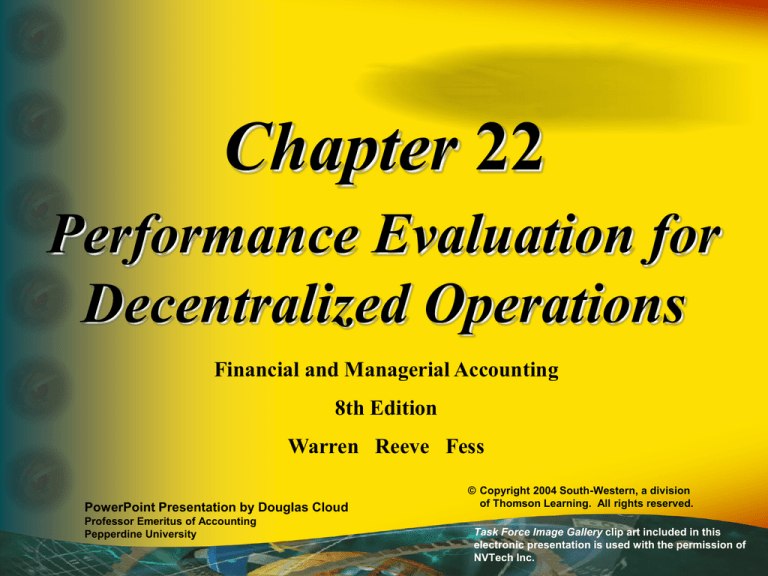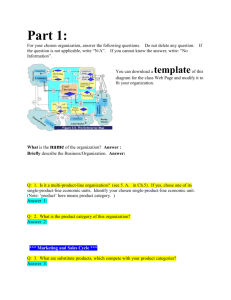
Chapter 22
Performance Evaluation for
Decentralized Operations
Financial and Managerial Accounting
8th Edition
Warren Reeve Fess
PowerPoint Presentation by Douglas Cloud
Professor Emeritus of Accounting
Pepperdine University
© Copyright 2004 South-Western, a division
of Thomson Learning. All rights reserved.
Task Force Image Gallery clip art included in this
electronic presentation is used with the permission of
NVTech Inc.
Some of the action has been automated,
so click the mouse when you see this
lightning bolt in the lower right-hand
corner of the screen. You can point and
click anywhere on the screen.
Objectives
1. List and explain the advantages and
After of
studying
this
disadvantages
decentralized
chapter, you should
operations.
be able to: accounting
2. Prepare a responsibility
report for a cost center.
3. Prepare responsibility accounting
reports for a profit center.
4. Compute and interpret the rate of return
on investment, the residual income, and
the balanced scorecard for an
investment center.
Objectives
5. Explain how the market price,
negotiated price, and cost price
approaches to transfer pricing may be
used by decentralized segments of a
business.
Centralized and
Decentralized
Operations
Advantages of
Decentralization
It allows managers to focus on acquiring
expertise in their areas of responsibility.
Decentralizing decision making provides
excellent training for managers.
Delegation improves employee morale.
Decentralization helps managers create good
customer relations by responding quickly to
customers’ needs.
Managers become more creative in suggesting
operating and product improvement.
Disadvantages of
Decentralized Operations
Decisions made by one manager
may negatively affect the
profitability of the entire organization.
Assets and operating costs are
duplicated (e.g., each division has
its own administrative office staff).
Responsibility Centers
Cost Centers
Managers are held accountable for controlling costs.
Profit Centers
Managers are held accountable for costs
and making decisions that impact revenues
favorably.
Responsibility Centers
Investment Centers
Managers are held accountable for
costs and revenues and are also held
accountable for the efficient use of
assets.
Responsibility Accounting
for Cost Centers
COST CENTERS IN A UNIVERSITY
UNIVERSITY
College of
Business
COLLEGE
Dept. of Marketing
College of
Engineering
College of Arts
and Sciences
Dept. of Accounting
Dept. of Management
Responsibility Accounting
for Cost Centers
COST CENTERS IN A UNIVERSITY
DEPARTMENT
Department
of
Accounting
Cost Centers
Budget Performance Report
Supervisor, Department 1—Plant A
For the Month Ended October 31, 2006
Budget
Factory wages
Materials
Supervisory salaries
Power and light
Depreciation
Maintenance
Insurance, taxes
Actual
$ 58,100 $ 58,000
32,500
34,225
6,400
6,400
5,750
5,690
4,000
4,000
2,000
1,990
975
975
$109,725
$109,725 $111,280
$111,280
Over
Budget
Under
Budget
$100
$1,725
60
10
$1,725
$1,725
These totals are shown on the Manager, Plant
A’s budget performance report (Slide 13).
$170
$170
Cost Centers
Budget Performance Report
Manager, Plant A
For the Month Ended October 31, 2006
Administration
Department 1
Department 2
Department 3
Budget
Actual
$ 17,500
109,725
$ 17,350
111,280
111,280
192,600
149,100
$470,330
190,500
149,750
$467,475
Over
Budget
Under
Budget
$150
$1,555
2,100
$3,655
From the Supervisor—Department 1, Plant A
budget performance report (Slide 12).
650
$800
Cost Centers
Budget Performance Report
Manager, Plant A
For the Month Ended October 31, 2006
Budget
Administration
Department 1
Department 2
Department 3
$ 17,500
109,725
190,500
149,750
$467,475
$467,475
Actual
$ 17,350
111,280
192,600
149,100
$470,330
$470,330
Over
Budget
Under
Budget
$150
$1,555
2,100
$3,655
$3,655
This is shown on the Vice-President’s
budget production report (Slide 15).
650
$800
$800
Cost Centers
Budget Performance Report
Vice-President, Production
For the Month Ended October 31, 2006
Over
Budget
Actual
Budget
Administration
Plant A
Plant B
$ 19,500
467,475
395,225
$882,200
$ 19,700
470,330
394,300
$884,330
Under
Budget
$ 200
2,855
$3,055
Note that “Over Budget” is a net figure.
$925
$925
Cost Centers
Budget Performance Report
Vice-President, Production
For the Month Ended October 31, 2006
Over
Budget
Actual
Budget
Administration
Plant A
Plant B
$ 19,500
467,475
395,225
$882,200
$ 19,700
470,330
394,300
$884,330
Under
Budget
$ 200
2,855
$3,055
Each of the line items above is
supported by a cost center report.
$925
$925
Responsibility
Accounting for
Profit Centers
In a profit center, the unit manager has the
responsibility and the authority to make
decisions that affect both costs and revenues.
Profit centers may be
divisions, departments,
or products.
Profit Centers
NEG, a diversified entertainment company,
has two profit centers: the Theme Park
Division and the Movie Production Division.
Revenues
Operating expenses
Theme Park Movie Production
Division
Division
$6,000,000
$2,500,000
2,495,000
405,000
Profit Centers
Charging Service Department Costs
to Production Divisions
Purchasing Department: $400,000
(Activity base: number of purchase requisitions)
Theme Park Division
Movie Production Division:
Total
$400,000
25,000 purchase requisitions
15,000 purchase requisitions
40,000
= $10 per purchase
requisition
40,000 purchase requisitions
Profit Centers
Charging Service Department Costs
to Production Divisions
Payroll Accounting: $255,000
(Activity base: number of payroll checks)
Theme Park Division
Movie Production Division:
Total
$255,000
15,000 payroll checks
12,000 payroll checks
3,000 payroll checks
15,000
= $17 per payroll check
Profit Centers
Charging Service Department Costs
to Production Divisions
Legal Department: $250,000
(Activity base: number of payroll checks)
Theme Park Division
100 billed hours
Movie Production Division: 900 billed hours
Total
1,000
$250,000
1,000 hours
= $250 per hour
Profit Centers
Nova Entertainment Group
Service Department Charges to NEG Divisions
For the Year Ended December 31, 2006
Service Department
Purchasing
Theme
Park
Division
$250,000
Movie
Production
Division
$150,000
25,000 purchase
15,000 purchase
requisitions xrequisitions
$10
x $10
per purchaseper purchase
requisition requisition
Profit Centers
Nova Entertainment Group
Service Department Charges to NEG Divisions
For the Year Ended December 31, 2006
Service Department
Purchasing
Payroll accounting
Theme
Park
Division
$250,000
204,000
Movie
Production
Division
$150,000
51,000
12,000 payroll3,000 payroll
checks x $17 checks
per
x $17 per
payroll checkpayroll check
Profit Centers
Nova Entertainment Group
Service Department Charges to NEG Divisions
For the Year Ended December 31, 2006
Service Department
Purchasing
Payroll accounting
Legal
Theme
Park
Division
$250,000
204,000
25,000
Movie
Production
Division
$150,000
51,000
225,000
100 hours x $250
900 hours x $250
per hour
per hour
Profit Centers
Nova Entertainment Group
Service Department Charges to NEG Divisions
For the Year Ended December 31, 2006
Service Department
Purchasing
Payroll accounting
Legal
Total service department charges
Theme
Park
Division
$250,000
204,000
25,000
$479,000
Movie
Production
Division
$150,000
51,000
225,000
$426,000
Nova Entertainment Group
Divisional Income Statements
For the Year Ended December 31, 2006
Theme Park Division
Revenues
Operating expenses
Income from operations
$6,000,000
2,495,000
$3,505,000
Income from operations before
service department charges.
Movie Production Division
$2,500,000
405,000
$2,095,000
Nova Entertainment Group
Divisional Income Statements
For the Year Ended December 31, 2006
Theme Park Division
Revenues
$6,000,000
Operating expenses
2,495,000
Income from operations
$3,505,000
Less service dept. charges:
Purchasing
$ 250,000
Payroll accounting
204,000
Legal
25,000
Total service department
charges
$ 479,000
Income from operations
$3,026,000
Movie Production Division
$2,500,000
405,000
$2,095,000
$ 150,000
51,000
225,000
$ 426,000
$1,669,000
Responsibility
Accounting for
Investment Centers
In an investment center, the unit manager has the
responsibility and the authority to make decisions
that affect not only costs and revenues but also
the assets invested in the center.
Investment Centers
Datalink Inc.
Divisional Income Statements
For the Year Ended December 31, 2006
Northern
Division
Central
Division
Southern
Division
Revenues
Operating expenses
Income from operations
before service dept. charges
Service department charges
Income from operations
$560,000
336,000
$672,000
470,400
$750,000
562,500
$224,000
154,000
$ 70,000
$201,600
117,600
$ 84,000
$187,500
112,500
$ 75,000
Invested assets
Rate of return on investment
$350,000 $700,000 $500,000
20%
12%
15%
20%
15%
Rate of Return on Investment (ROI)
Revenues
Rate of Return on Investment (ROI)
Profit
Investment
Turnover
Profit
Margin
Rate of Return on Investment (ROI)
The
investment
turnover
indicates
the rate of
sales on
each dollar
of invested
assets.
The profit margin
indicates the rate of profit
on each sales dollar.
Investment
Turnover
Profit
Margin
Rate of Return on Investment (ROI)
Income
from
operation
Sales
ROI =
x
Sales
Invested assets
ROI =
$ 70,000
$560,000
x
$560,000
$350,000
ROI = 12.5% x 1.6 = 20%
Rate of Return on Investment (ROI)
Income
from
operation
Sales
ROI =
x
Sales
Invested assets
Profit
Margin
Inventory
Turnover
Profit Margin
Income from operations
Revenues (Sales)
Profit margin
Northern
Division
Central
Division
Southern
Division
$ 70,000
$560,000
12.5%
$ 84,000
$672,000
12.5%
$ 75,000
$750,000
10.0%
Revenues (Sales)
Invested assets
Investment turnover
$560,000
$350,000
1.6
$672,000
$700,000
.96
$750,000
$500,000
1.5
Return on Investment (ROI)
Income from operations
Invested assets
$ 70,000
$350,000
$ 84,000
$700,000
$ 75,000
$500,000
20%
12%
15%
Investment Turnover
Rate of return on investment
Income
from
Operations
–
Minimum
Acceptable
Rate of
Return on
Assets
=
Residual
Income
Baldwin Company
Divisional Income Statements
For the Year Ended December 31, 2006
Northern
Division
Income from operations
Minimum acceptable income
from operations as a percent
of invested assets:
$350,000 x 10%
$700,000 x 10%
$500,000 x 10%
Residual income
Central
Division
Southern
Division
$70,000 $84,000 $75,000
35,000
70,000
50,000
$35,000 $14,000 $25,000
The balance scorecard is a set of
financial and nonfinancial measures
that reflect multiple performance
dimensions of a business.
Innovation and
Learning
•
•
•
•
R&D investment
R&D pipeline
Skills and training
Time to market
Internal
Process
Customer
• Satisfaction
• Loyalty
• Perception
Financial
•
•
•
•
•
ROI
Residual income
Profit
Cost
Sales
• Efficiency
• Quality
• Time
Transfer Pricing
Transfer Pricing
When divisions transfer products or
render services to each other, a transfer
pricing is used to charge for the products
or services
Benefits of Transfer Pricing
1. Divisions can be evaluated as profit or
investment centers.
2. Divisions are forced to control costs and
operate competitively.
3. If divisions are permitted to buy component
parts wherever they can find the best price
(either internally or externally), transfer
pricing will allow a company to maximize
its profits.
Commonly Used Transfer Prices
1. Market price approach sets the price at which
the product transferred could be sold to outside
buyers.
2. Negotiated price approach allows decentralized
managers to agree (negotiate) among
themselves.
3. Cost price approach (variable or full) uses a
variety of cost concepts for setting the transfer
price.
Commonly Used Transfer Prices
Variable Cost
per Unit $10
Full Cost
per Unit $13
Negotiated Price
Market Price
per Unit $20
Transfer Pricing—Negotiated Price Approach
Assumptions
1.Division M produces a product with a variable
cost of $10 per unit. Division M has unused
capacity.
2.Division N purchases 20,000 units of the same
product at $20 per unit from an outside source.
If the division managers agree on a price of
$15 per unit, how much will each
division’s income increase?
Chapter 22
The End





